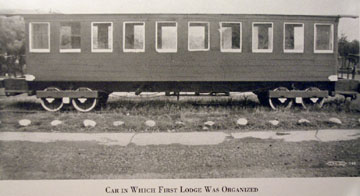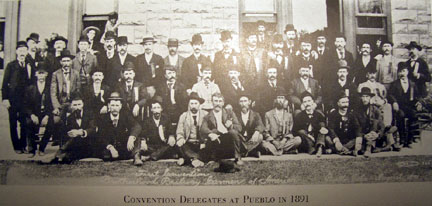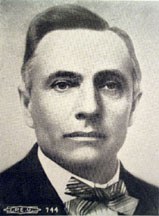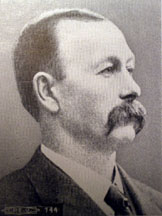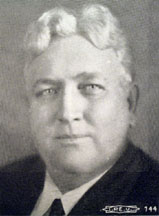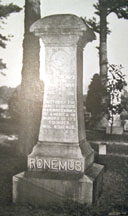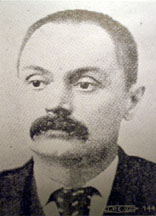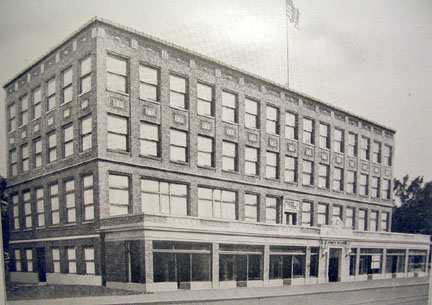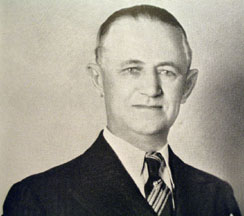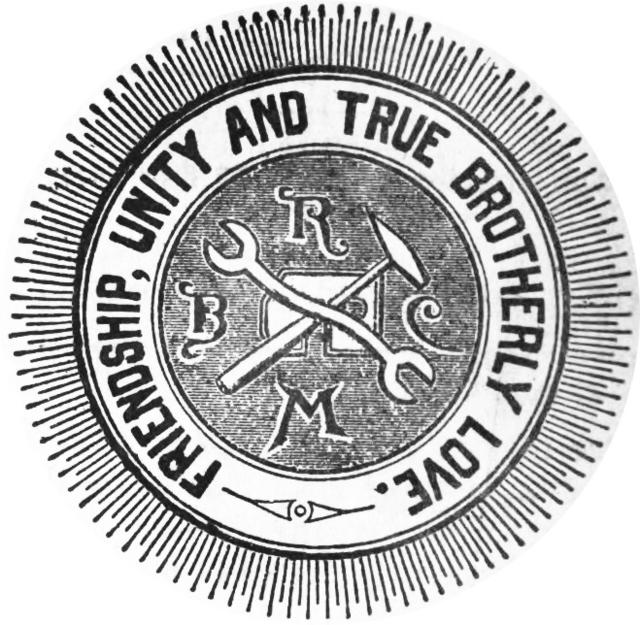The First 50 Years of the
Brotherhood Railway Carmen
www.tcu6760.com
Steven L Pequignot
Heartland Lodge 6760
Version 25.2.18
After years of working seven days a week, 12 hours per day, for $0.10 per hour, with no benefits and no representation, seven carmen met in the coach shown above, at a shop track in Cedar Rapids, October 27, 1888, to form the first lodge in the Brotherhood. It was fitting that William H. Ronemus was elected the first Grand Chief Car Repairer (now referred to as the General President). Alex Lynott was elected as the first Grand Secretary-Treasurer. The early name of the organization was called the Brotherhood of Railway Car Repairers of North America.
The First Annual Convention of the Brotherhood was held in Topeka, Kansas on September 9, 1890, during which, the delegates drafted its first declaration of principles of the Brotherhood and declared that the intent and purpose of the Brotherhood is to promote Friendship, Unity and True Brotherly Love among its members. The delegates elected William H. Ronemus as Grand Chief Carman (now referred to as General President); W. S. Missemer as Vice Grand Chief Carmen; Sylvester Keliher, the Mutual Aid organizer was elected Grand Secretary-Treasurer. The first Grand Executive Board was elected at this convention, including R. Hazelwood, Charles Riach, P. Kelly, J. Wyman and Frank L. Ronemus.
Car in Which First Lodge Was Organized
Convention Delegates at Pueblo in 1891
The Second Grand Lodge Convention was held in 1891, at Pueblo, Colorado. In one year since the last convention the Brotherhood grew from 14 lodges to 60 lodges in 16 states. Another organization called the Car Inspectors, Repairers and Oiler Mutual Benefit Association was organized in Indianapolis, Indiana. This group voted to amalgamate with the Brotherhood, thus changing the name of our organization to the Brotherhood Railway Carmen of America. At this convention delegates authorized placing the Grand Chief Carman on a salary.
Grand Lodge Officers elected at the second convention were: Grand Chief Carmen W. S. Missemer; Vice Grand Chief Carmen B. F. White; Grand Secretary-Treasurer S. Keliher. Elected to the Grand Executive Board were: W. H. Ronemus, W. T. O'Donnell, W. A. Brown, John Caples, and N. B. Chambers.
The third Grand Lodge Convention was held in 1892, at St. Louis, Missouri. In just four years the Brotherhood became international by organizing lodges in Canada. The total number of lodges in 1892 exceeded 150. Grand Lodge Officers elected in 1892 were: Grand Chief W. S. Missemer, Grand Vice Chief B. F. White, Grand Secretary-Treasurer S. Keliher; Grand Executive Board S. P. Downey, W. H. Ronemus, John Caples, J. H. Rosen, H. J. Dacres and S. Keliher. Pay scales varied from road to road, however, in just four years Brotherhood members' pay rose from $1.20 per day to $2.50 to $ 3.25 per day.
After a prosperous six years, the Brotherhood threatened by the American Railway Union. Sylvester Keliher resigned from the Brotherhood to become secretary of the ARU. This brought much dissension among grand lodge officers and in the ranks. By the Fourth Grand Lodge Convention June 16, 1894, in Chicago, there were only 36 delegates for the first biennial and the fourth in the organization's history. It was difficult to find members to run for office. Grand Chief Missemer refused to run for reelection. The man elected Grand Chief was expelled within a few months and replaced by F. A. Symonds. Records indicate that Frank L. Ronemus was reelected Grand Secretary-Treasurer. After the Executive Board audited the accounts it turned over $32 to the Grand Secretary-Treasurer, with only 38 local lodges still in good standing. The Brotherhood's headquarters remained in Minneapolis.
By the time of the fifth Grand Lodge Convention in 1896, held in Dallas, only 7 lodges were represented. The Grand Lodge Secretary-Treasurer was reduced to have his office in his home. William H. Ronemus was brought back as Grand Chief Carman. D. B. Kane was elected Vice Grand Chief Carman and Frank L. Ronemus was reelected Grand Secretary-Treasurer. The financial situation was not healthy, however, the 7 delegates foresaw future progress in the order.
Between the fifth and sixth Grand Lodge Conventions further cutbacks were necessary. The Carmen Journal was discontinued from 1896 and would not return until 1899.
By the time of the sixth Grand Lodge Convention in St. Louis on September 12, 1899, the Carmen Journal had reappeared in June, which helped in organizing about 40 new lodges. Due to the sacrifices of William Ronemus, the Brotherhood appeared to be in harmony once again. William Ronemus was reelected as Grand Chief Carman. Others elected were: N. G. Eaton, First Vice Grand Chief Carman; Frank L. Ronemus, Grand Secretary-Treasurer; W. C. Allen, Second Vice Grand Chief Carman; Ira T. Corbitt, Third Vice Grand Chief Carman. Elected to the Grand Executive Board were: B. F. Miller, W. F. Luffman, B. D. Kane, A. E. McReynolds and C. L. Millhouse.
The seventh convention met in Kansas City, September 10, 1901. The delegates approved the formation of a ladies auxiliary, authorized once again a salary for the Grand Chief Carman and provide a $100 per month salary for the Grand Secretary-Treasurer. Joseph B. Yeager was elected Grand Chief Carman to succeed William Roneums. Frank Ronemus was reelected Grand Secretary-Treasurer. Vice Grand Chief Carmen elected were: W. C. Allen, Z. T. Seymour, and A. J. Ross. Grand Executive Board members: W. F. Luffman, T. H. McLees, Frank Hall, John W. Watts, and V. B. Dunkum.
The eighth convention held in St. Louis in September 1903. C. M. Suiter was elected Grand Secretary-Treasurer and suddenly passed away November 16 the same year. He was replaced by W. L. Detwiler, but before the term expired he resigned and was replaced by W. F. Donaldson. Additionally, Frank L. Ronemus was elected Grand Chief Carman. Vice Grand Chief Carmen were: W. C. Denius, Hugh Jones, John Suthons, Walter Dufton, and Mike Kelley. At this time membership was about 20,000. Action at this convention relieved the Grand Secretary-Treasurer of his duties as editor of the Journal. The first Editor & Manager of the Journal elected was W. J. Adames
The ninth convention met in Buffalo, New York in 1905. Grand Chief Carman Frank L. Ronemus was reelected along with Vice Grand Chief Carmen M. F. Ryan, L. L. Hannah, John Suthons, B. P. Lewis, F. A. Geiger; Grand Lodge Secretary-Treasurer J. W. Watts and Editor & Manager of the Carmen Journal W. J. Adames. Grand Executive Board Members were Frank Hall, J. W. Bartholomew, J. A. Hill, G. F. Mounts & W. S. Brown. This convention was unique as it was a joint convention with the International Association of Car Workers in an effort to merge the two unions. The motion was rejected by the delegates. A unified front was a long way off.
The tenth convention held in Chicago in 1907 saw an increase in membership and new problems, such as threatened wage reductions. Delegates approved a salary for all vice grand chief officers, which provided them more time to work on union matters. Elected Grand Lodge Officers were: Grand Chief Carman Frank L. Ronemus; Vice Grand Chief Carmen: M. F. Ryan, L. L. Hannah, John Suthons, J. H. Spelts, I. M. Wallace. Grand Secretary-Treasurer, E. W. Weeks. During the past two years the Grand Chief Carman had traveled nearly 80,000 miles while on union business.
The eleventh convention in Atlanta began September 14, 1909. This convention saw many new changes for the Brotherhood. It was the first convention that did not include the name of one of the Ronemus brothers on the ballot. The office title of Grand Chief officers were replaced with General President, General Vice President, General Secretary-Treasurer, etc. Delegates approved changing the convention from every two years to every four years. Elected officers were: Martin F. Ryan, General President; Vice Presidents: Frank Paquin, Alfred Chartrand, I. M. Wallace, J. H. Spelts, J. J. Gallagher; General Secretary-Treasurer, E. W. Weeks. Following the convention a tribute to the leadership of Frank Ronemus was made on behalf of his many years of service to the Brotherhood.
Going into the twelfth convention in 1913 at Milwaukee the Brotherhood's membership had nearly doubled in the past four years. With a rapidly growing and widely located membership, delegates approved to add a new officer. The title of Assistant General President went to Felix H. Knight. General President Ryan highlighted important achievements over the past four years, including the Brotherhood's affiliation with the ALF and the Railroad Employes' Department. The payment of more than $6,500 owed to the delegates for attending the Atlanta convention. Strike fund payments to our members in excess of $203,000. During the four year period since the last convention the General Secretary-Treasurer handled $450,496.21, with every penny accounted for. Officers elected at this convention were: General President Marin Ryan; Assistant General President Knight as noted above; General Vice Presidents: Frank McKenna, George A. Nolte, J. H. Spelts, J. J. Gallagher, Frank Paquin, William H. Ronemus, Alfred Charlrand, G. H. Kennedy, & F. J. McCreery. General Secretary-Treasurer, E. W. Weeks. The financial affairs of the Brotherhood were the soundest in history and membership growth had exceeded expectations.
Approaching the thirteenth convention in Fort Worth in 1917 the Brotherhood saw the workday reduced from 12 hours to 10 hours and at most points Carmen worked a 9-hour day, and labors big push to reduce it to an 8-hour day was making headlines. The Brotherhood already had 8-hour day agreements with about 25 railroads. The remaining roads were required to provide an 8-hour day to all shop craft employees when the government took control of all railroads during World War I. At this time there were 691 lodges representing nearly 55,000 members. The Brotherhood lost two loyal officers in this time period. Past Grand Chief Carman, current General Vice President, and founder of the Brotherhood William H. Ronemus passed away December 8, 1916. Less than a year later, Mrs. Marie R. Ronemus, Grand President and founder of the Loyal Star passed away September 11, 1917. She was the wife of Frank Ronemus. Officers elected at the 1917 convention were: General President M. F. Ryan; Assistant General President Knight; General Secretary-Treasurer E. W. Weeks; General Vice Presidents: Frank McKenna, George A. Nolte, J. H. Spelts, Frank Paquin, J. F. McCreery & Louis Beuloin.
Between the 13th and 14th conventions the Transportation Act of 1920 returned the railroads to private ownership and the United States Labor Board was created by Congress. Also, on May 22, 1920, Past Grand Chief Carman and Past Grand Secretary-Treasurer, Frank L. Ronemus passed away. It was actually Frank's dream to create a union organization for carmen as early as 1881. It took seven years for Frank and his brother William to fulfill this dream.
The fourteenth convention was held in August 1921, in Toronto. All shopcrafts worked 8-hour days, still 7 days per week. The Railway Adjustment Board No. 2 was established to consider grievances. There were 1,174 lodge in the Brotherhood in December 1918. By the convention there were 1,465 lodges an approximately 200,000 members. General Present Ryan, Assistant General President Knight and General Secretary-Treasurer Weeks were reelected along with the following vice presidents: Frank McKenna, George Nolte, J. H. Spelts, Frank Paquin, J. F. McCreery, D. J. Collins, D. A. Crosswhite, Adolph Werner, Edward Mr. Ware, G. F. Mounts and J. M. Patterson. Post-war difficulties were still to come.
William H. Ronemus
Founder of the Brotherood Railway Carmen
Frank L. Ronemus
Martin F. Ryan
Inscription
W. H. Ronemus
Born Jan. 15, 1852
Died Dec. 8, 1916.
Erected by the Brotherhood Railway Carmen of America in memory of its founder W. H. Ronemus.
It was at this convention the delegates approved the purchase of a 4 1/2-story building at the corner of Linwood & Baltimore Avenue in Kansas City. The building was considered fire-proof. In 1909 the Brotherhood's offices consisted of four rooms in the Hall Building in Kansas City and increased to 16 rooms in 1925, none of the rooms were fire-proof. The building on the right would become the Brotherhoods headquarters for the next 24 years.
The 16th convention met again at Kansas City September 16, 1929, just weeks before the financial crash starting the great depression. Feeling the sense of urgency and financial terror, the delegates met, acted and adjourned routine business. Records reveal this convention was the first to mention air and bus travel and what effect these modern devices will have on the railroad industry in the future.
Brotherhood Railway Carmen of America Building
1925 - 1949
Leaders of the Brotherhood
Grand Chief Carmen/Presidents
1888 to 1938
1. William H. Ronemus 1888-1891
2. W. S. Missemer 1891-1894
3. F. A. Symonds 1894-1896
4. William H. Ronemus 1896-1901
5. Joseph B. Yeager 1901-1903
6. Frank L. Ronemus 1903-1909
7. Martin F. Ryan 1909-1935
8. Felix H. Knight 1935-1938
Joseph B. Yeager
Felix H. Knight
Between the 14th and 15th conventions the cost of living rose dramatically after the war. The Labor Boards' trend of improving labor's working conditions and wages were turned. After two wage reductions, the establishment of unjust working conditions and allowing railroads to contract out their work, a strike vote was taken. After ballots were counted, 97% of the members had voted for a strike. Accordingly, on July 1, 1922, the greatest strike ever in the history of American organized labor began. The strike was 95% effective nationwide. The great strike of 1922 was on.
The 15th convention at Kansas City in September, 1925, General President Ryan presented his report to the delegates. Records indicate the only topic of importance was the strike. It would be until the Railway Labor Act was signed May 20, 1926, that the Brotherhood would once again have its members gainfully employed and making gains in the workplace. The convention reelected General President Ryan & Assistant General President Knight. E. W. Weeks, in ill health resigned and J. M. Ellis was elected as General Secretary-Treasurer. General Vice Presidents elected were: Frank McKenna, S. L. Watts, J. H. Spelts, Frank Paquin, J. F. McCreery, Louis Beuloin, D. J. Collins, Irvin Barney, Adolph Werner, Edward M. Ware, A. J. Berger and J. M. Patterson.
Officers elected at the 1929 convention were General President Ryan, Assistant General President Knight, General Secretary-Treasurer J. M. Ellis. General Vice President Frank Paquin was compelled to resign due to ill health. A. J. Berger also resigned. All other incumbent vice presidents were reelected. E. K. Hogan and J. V. Rattigan were elected to replace the two officers who resigned.
The period of the great depression was on and as a result the convention scheduled for 1933 was canceled. In early 1935 General President Ryan contracted a cold while in Chicago attending conferences. After returning to headquarters in Kansas City a doctor order him to bed rest in a hospital. Two days later on January 17, 1935 Martin Francis Ryan passed away. He was deep in work almost to his last breath. Five days later Felix H. Knight was installed as General President to succeed him.
After taking office General President Knight began a determined drive to increase membership and urged members to vote for a convention in 1935. In August 1935, the 17th convention was held in Montreal. At this convention General President Knight gave a speech recommending a 6-hour work day and a 5-day a week position for carmen. Needless to say, the delegates applauded the idea and Brother Knight was elected to his first full term as General President. Also elected were: Assistant General President Irvin Barney; Vice Presidents: J. F. McCreery, D. J. Collins, Edward M. Ware, J. M. Patterson, E. K. Hogan, John V. Rattigan, Louis Mastriani, L. A. Baudry, R. S. Roberts, John W. Seabolt, Robert Hewitt and Maurice O'Connor; General Secretary-Treasurer, J. M. Ellis and W. J. Adames, Editor & Manager of the Carmen Journal. The 6-hour workday has never been achieved and the 5-day workweek would not become reality until after World War II.
The original Railroad Retirement Act had been rendered invalid by the Supreme Court. In 1937 the railroad industry started to recover from the great depression. The amended Railway Retirement Act of 1937 adopted by Congress and signed into law by President Roosevelt, an increase in wage of $0.05 an hour, restoration of pay rates on Canadian railroads and the continued pressure to remove company run unions all brought favorable changes to rail employees.
These events led to 1938, which marked the 50th anniversary of the Brotherhood. In these 50 years, organized rail labor achieved many benefits considered unattainable in that time period. Instead of being enslaved to the railroad 12 hours a day, seven days a week. Railroad employees now have time from the job to rest and actually enjoy time with their families and friends.
Railroad employees of today enjoy a safe and secure rail career due to the effort and dedication of the officers mentioned above. We are forever grateful.
Lodge 6760 wishes to thank Mrs. Sandy Maxim from Grand Lodge Headquarters and Steve Wilhelm, Director of Constitution and Laws, for providing the historical material that enabled us to research this time period of the Brotherhood and present it here.
Photographs courtesy of Sandy Maxim, Grand Lodge Headquarters, unless otherwise noted below the photo. Webmaster's note: As of December 2012, Sandy Maxim is the only remaining staff member in the Brotherhood who worked at the old BRC Headquarters in Kansas City.
Photo courtesy of the Robert & Lynda Maier Library, Poughkeepsie, NY
The photo above is a copy of the Official Photo of the 1921 Brotherhood Railway Carmen of America Grand Lodge Convention, taken by Alexandra Studios, Toronto, Canada. The official photo is framed, under glass and measurers 56 X 12 inches.
The first BRC logo from the 1880s


